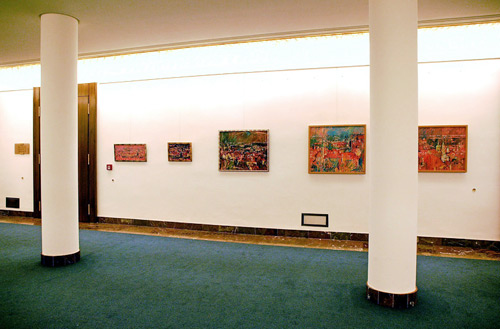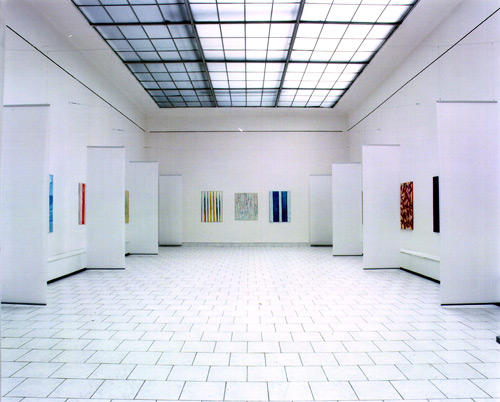Josef Fronk
akademický malířMgr. Kamil Nábělek
Jan 10, 2005
Prague
When we stand in front of Josef Fronk’s Prague pictures, our thinking can take one of two different directions. We can either focus on the artistic and historical context connected to the portrayal of the city, especially Prague, which would be the approach favoured by experts, or focus directly on the theme itself, i.e. on the portrait of the city we are familiar with, based on our experience.
In the first case, we would have to summon up practically the whole tradition of European painting, stretching back to depictions of ancient ports, vividly captured by the murals at Pompeii, of Jan van Eyck and Pieter Bruegel with their Dutch townscapes, of Bellini, who was inspired by Venice, of El Greco and his townscape of Toledo covered by a dark thunderous sky, of Canallet and his townscapes of London, of Turner’s painting of Venice, of Bellot, who painted Dresden, of Corot, Pissaro and Monet, of Schiele’s depiction of Krumlov, etc.
If we focus exclusively on the Prague tradition, it is necessary to consider the work of Antonín Slavíček and the famous series by Oskar Kokoschka. After such a compendium of characters, the question necessarily arises, whether it is possible to add anything to such a sequence, and whether each such addition is mere repetition. In the second case, which is not concerned by historical context, but by the image of Prague as it appears today, we do not have to ask questions about artistic traditions and their innovative subversion; but instead we are interested in whether our conception of Prague matches that of artist’s and where it differs. Both approaches are valuable – and yet, both share a fundamental flaw: they lead us away from the paintings on view. Historical synopsis tends to classify the seen into a structure of codified cultural heritage. In effect, it is a kind of conceptual caption of the seen.
The second tendency, which emerges from our personal observations, is largely formed by our practical experience, i.e. our topographical knowledge of Prague.
Ultimately both ways – conceptual and practical alike – finally converge, for the concept is used, most frequently, to find and determine certain rules governing the plurality of phenomena that surrounds us. In other words, it is used to conceptually reduce such a plurality and in its practical control.
Such a practical-conceptual basis of our everyday experience eventually leads to the fact we do linger long over the things we observe. Usually we do not focus for long on any particular object. From the sights on offer, we look for practically recognisable, conceptual classification; above all, the concept to which we could assign a specific object that enables us to use it. And so we are done with everything so quickly – with works of art, our insights into the natural world, and with all significant facts of life. We are satisfied if a picture of Prague recalls the tradition of Antonín Slavíček and Oskar Kokoschka, or even more simply if we can say to ourselves, “Yes, this is Prague Castle, here stands St. Nicolas and there the National Theatre.” Thereby the matter is generally brought to a close.
But not until we put aside our efforts to replace things with practically useable concepts will we finally be able to see objects and the world as they truly are. Our cognitive abilities shall suddenly serve not only as a means to attain worldly goals. Thanks to such a shift in perspective, such disruption, cognitive abilities that usually serve as a kind of lantern to illuminate our path, will be transformed into daylight to open up the world. It is possible that the easiest way to relate to Josef Fronk’s pictures, is by looking at them fully conscious of the fact that art, no matter how realistic it is, is not an illustration of something that exists outside of itself. An appreciation of the originality of artistic expression in the light of older approaches, or the ability to correctly match a picture’s elements to real life buildings are not the sole criteria. More important is to realize that through art we create a specific and peculiar relation to reality, and that art is not essential for what it is expresses, but for the fact that it exists and forces our response. Perhaps this is because it temporarily halts of our efforts to reach a visible goal. It is sufficient for us to watch things with certain intellectual contemplativeness and aimless thoroughness. This sensibility to what exists, while first showing us the beautiful things around us, eventually leads us to the simplest, yet the most intrinsic corner of our lives – what is hidden within our very being.
It is strange, but after all, it looks as if painting Prague and looking at pictures offers some kind of understanding that, since it is not governed by any practical motives, enables us to discern and live through more deeply and more intensely both the things around us, and ourselves.

Mgr. Kamil Nábělek
2001
White Verticals
The exhibited collection of paintings, created last year, represents one of the periods of Josef Fronk's artistic career. All of the paintings show a similar basic structure - an abstract colour surface with penetrative white vertical stripes. The vertical structure is the bearer of the visual order and also certain spiritual meaning given to it by the author. Josef Fronk understands abstract painting as a means of expression of emotional condition able to even disclose certain deeper, intuitive structures of our personality. As something able to grasp the deeper, more subtle aspects of our lives and of our world, and maybe as something capable of approximating the spiritual dimension of being. His concept of abstract painting is by no means formal, limited to structuring the surface and work with colour elements, rather trying to add to this level (the surface level of the painting in the literal meaning of the words) another spiritual, or metaphysical dimension. This is also how you may understand the name of the exhibition: "White Prayers". Prayer is a form of communication opening the transcendental space thanks to operation of mercy. The space of mercy and transcendence is not fully controlled by us. Thinking about prayer from the Christian point of view, I believe that the purpose of prayer is not to get God on our side, make Him want what we want, but to get to His side, let Him lead us to wanting what He wants. I do not mean to preach here, nor do I mean to render Josef Fronk's paintings on the religious basis, for that would be a wrong approach to them. I just mean to clarify Fronk's basic approach to creation, how his mind was tuned up. I believe Josef Fronk to wish to be led to what painting wants, through emotional perception of the act of painting. Just like we turn to God as a person in prayer, Fronk also wants the painting to give him answers, to show him the way, to lead him to the revelation of what has so far been hidden from man's eyes. This dynamic and existential aspect of prayer, which is an expression of living faith, in its generality (let me emphasize once again: not in its specifically religious form) is present in the essence of Josef Fronk's abstract painting. If we realise this basic orientation, some aspects of his painting will stand out more clearly to us. We can see then that the applied elements of image, in addition to their artistic value, also have a content: the vertical structure of the paintings, lending the image its basic order, is more than just organisation of space, at the same time representing a certain spiritual principle. The attempt at a precise and sensitive line is an attempt at preciseness of expression, trying to express a sensitive and reserved approach to the reality with the very brush stroke. The same can be traced in the colour composition, where white and blue are colours of spirit, while red is the colour of vitality. The blue colour, thanks to the technique of colour washing, in addition shows bright depths, opening the surface of the painting to contemplation. Thanks to this basic orientation we can understand the visual aspect of the paintings better, and comprehend more profoundly the tuning and outlook of the author himself. You have to realize that prayer has often been accompanied with sacrifice and fasting. I am not saying this to make Josef Fronk's efforts heroic and define himself as a saint of painting and a martyr of art. All I want to suggest is that all of those activities are above all activities open tot he future, open to what is about to come. In other words, I mean to say that Josef Fronk has been putting a lot of effort into the task he has put before himself, and we should follow his achievement in future too.

Pavel Luffer
2000
Spiritual Space
Visual expression cannot be described in words, which only blur the real meaning. It is not the sounds combined into words, sentences and ideas, it is direct speech that mirrors human urges, anticipations, fears, and affections. It is direct speech where colours and shades, relationships of shapes, structures, the contrast of the light and the darkness …. are words, sentences and ideas of another mode of communication. Words often distort, bias and manipulate. Create inaccurate and sometimes false images not approaching the essence of the utterance. The language of visual expression, on the other hand, is linked to certain peculiar levels of our conscience. Josef Fronk's paintings are just paintings. And it is not significant whether the inspiring content is or is not present in them. What is significant is the image, what it communicates, its spiritual space, radiation of energy, emotion, contact. Josef does not feel ashamed to feel and show deep emotion - joy, pain, brief moments of happiness, vigour. He rejects the expediency of concept, he does not like to reason in terms of topicality, fashion, or the dictate of post-modernism. As to the formal aspect of his paintings the unifying element of his recent achievement has been vertical line. For some an association of prison, pyjamas, striped mattress, corn or other things. For Josef the vertical is rather a symbol of vitality, way up, firmness and certainty. The certainty of joy in pain, the certainty of order in chaos, the certainty of waking up in the uncertainty of tomorrow. The two basic spaces to the right and to the left of the line represent the decisive element of expression, overlapping to hide and to create, to structure, to build, to organize shivers, fragments, and vigorous gests. The excited colour stains and traces are contrasted to exact shape specification. The contrast is not only in the psychology of shapes and their reversion from chaos to order, but also, and in the first place, in the expressiveness and building capacity of colour. The stained beige of old oil paints of staircases, the bright blue of the high summer sky. Closed and open space. The colour is not an aid, a description, it is a metaphor, a means to express the mission of the painting, an introvert communication of deeply emotional life.